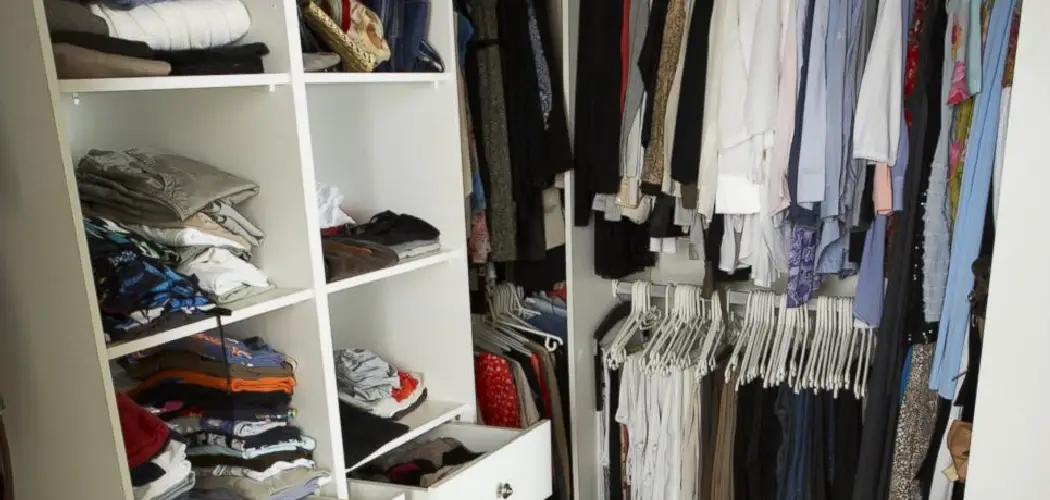Are you planning to downsize your wardrobe? You might be moving into a smaller space, simplifying your life, or simply decluttering.
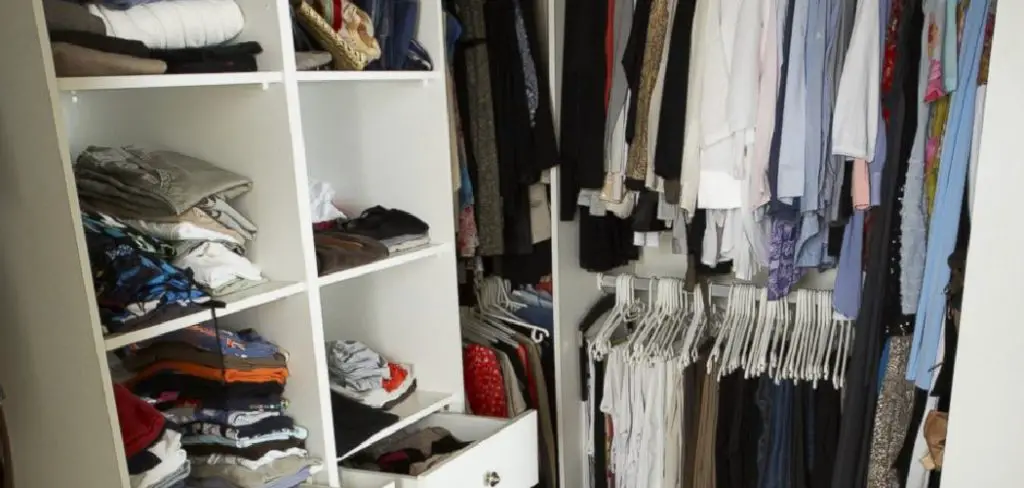
Downsizing your wardrobe can be a liberating process, freeing up physical and mental space. Whether you’re aiming for a simpler lifestyle, preparing for a move, or looking to refine your style, streamlining your closet can be highly beneficial. This process involves evaluating which items genuinely bring value and joy and understanding what pieces are essential to your lifestyle. Adopting a more intentional approach to clothing can create a curated wardrobe that better represents your preferences while reducing clutter.
In this guide on how to downsize wardrobe, we will explore effective strategies that simplify the downsizing process and help you maintain an organized, functional wardrobe. Let’s get started!
What Will You Need?
Before you begin downsizing your wardrobe, gathering the necessary tools and materials is important. These may include:
- Storage containers or bins
- Hangers and hanging organizers
- Baskets or shelves for folded items
- Labels or tags for organizing categories
- A full-length mirror for trying on outfits
Having these supplies on hand can make the process more efficient and organized. Depending on the size of your wardrobe, you may also want to set aside a specific amount of time each day or week to work on downsizing. This will prevent you from feeling overwhelmed and help you stay focused.
10 Easy Steps on How to Downsize Wardrobe
Step 1. Assess Your Current Wardrobe:
Begin by taking inventory of everything you own. Pull out all clothing items from your wardrobe, including those in drawers, boxes, or off-season storage. Lay them out so you can see each piece. This step is crucial as it provides a complete overview of your clothing collection. As you go through this process, note how often you wear each item, if it fits well, and whether it complements your style and lifestyle. Consider creating categories such as “Frequently Worn,” “Occasionally Worn,” and “Rarely or Never Worn” to help organize your thoughts. This honest assessment helps identify which items are precious to you and lays the foundation for the downsizing process.
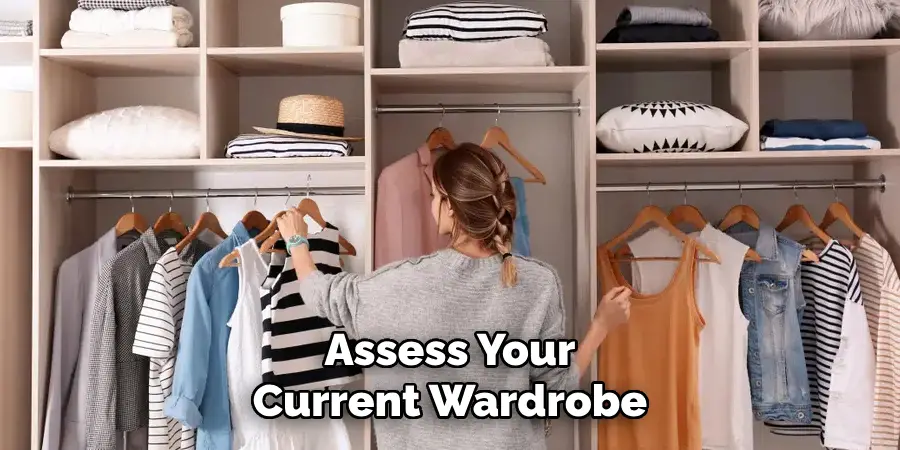
Step 2. Set Clear Goals and Priorities:
After assessing your current wardrobe, it’s essential to establish clear goals and priorities for downsizing. Determine what you want to achieve by decluttering your clothes. Whether creating a capsule wardrobe, focusing on quality over quantity, or simply keeping only items you love, having a clear objective will guide your decisions. Consider lifestyle changes or plans that may influence your wardrobe needs, such as a job change, climate differences, or personal style evolution. By setting these goals, you’ll have a benchmark to measure against as you start sorting through your clothing, ensuring the process aligns with your vision for a streamlined wardrobe.
Step 3. Sort and Categorize Your Clothing:
With your goals in mind, begin sorting through your clothing and categorizing each item. Use the categories you identified during your assessment, such as “Frequently Worn,” “Occasionally Worn,” and “Rarely or Never Worn.” Additionally, you might create piles of items to keep, donate, sell, or recycle. Be honest about whether each piece serves your current needs and aligns with your style. If you’re unsure about specific items, try them on and consider how you feel about them. This thorough sorting process will help you see what you truly value and what can be let go, making it easier to build a functional wardrobe that reflects your personality.
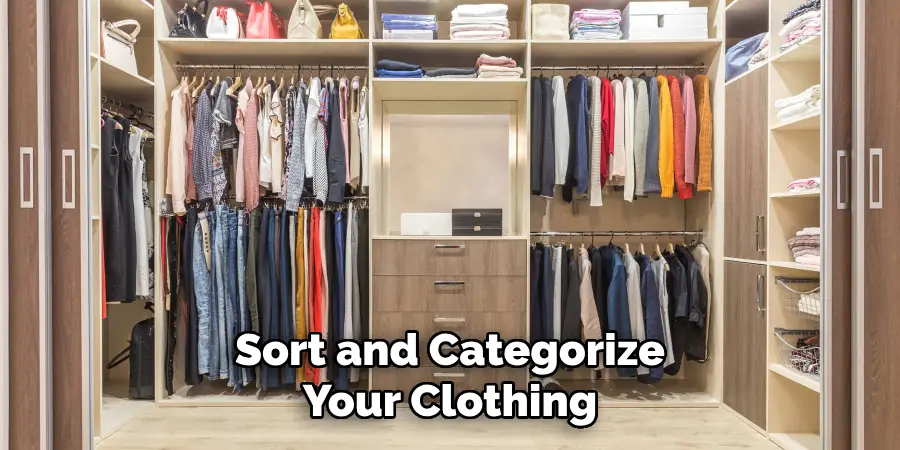
Step 4. Evaluate Quality and Condition:
Once you’ve sorted your clothing into categories, look closer at the quality and condition of each item you plan to keep. Check for any signs of wear and tear, such as stains, tears, or fading, and consider whether these can be repaired or if it might be time to let go of the item. Prioritize keeping pieces in good condition and made from durable, high-quality materials, as they are more likely to last longer and withstand regular use. Evaluating quality and condition ensures that your downsized wardrobe is both practical and long-lasting, allowing you to invest in pieces that truly enhance your style.
Step 5. Organize and Store Seasonal Items:
To make your wardrobe more manageable, consider organizing your clothing by season. Store off-season items in separate bins or storage containers that can be tucked away until needed. This approach creates more space and makes it easier to access and see the clothes relevant to the current season. When arranging seasonal items, ensure they are clean and in good condition before storing them to prevent damage. Labeling bins with the appropriate season can further streamline the process, making transitioning between summer, fall, winter, and spring clothing hassle-free. By organizing seasonal clothing efficiently, you maintain an uncluttered wardrobe perfectly tailored for the time of year.
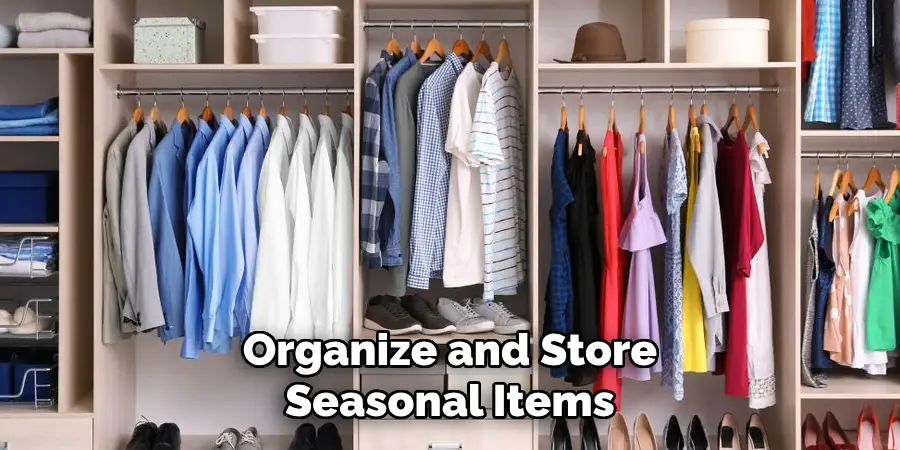
Step 6. Identify and Keep Versatile Pieces:
During the downsizing process, focus on identifying versatile pieces that can be styled in various ways and worn for different occasions. These items often include classic staples such as a well-fitted pair of jeans, a tailored blazer, or a simple black dress. Versatile clothing maximizes your outfit choices and serves multiple purposes, reducing the need for excess items in your wardrobe. As you evaluate your clothing, consider the number of outfits each piece can contribute to and how easily it pairs with other items. Prioritizing versatile pieces ensures that your downsized wardrobe remains functional and flexible, allowing you to dress easily and confidently for any occasion.
Step 7. Declutter Accessories and Footwear:
In addition to clothing, assessing your accessories and footwear when downsizing your wardrobe is essential. Review items such as shoes, belts, bags, hats, and jewelry, and consider their frequency of use and alignment with your current style. Sort these accessories into categories similar to your clothing, such as “Frequently Used,” “Occasionally Used,” and “Rarely or Never Used.” Keep items that complement multiple outfits, serve a specific functional purpose, or hold significant sentimental value. Let go of those that are redundant, out of style, or no longer suit your needs. Remember to review your footwear collection, considering comfort, quality, and versatility when deciding which pairs to keep.
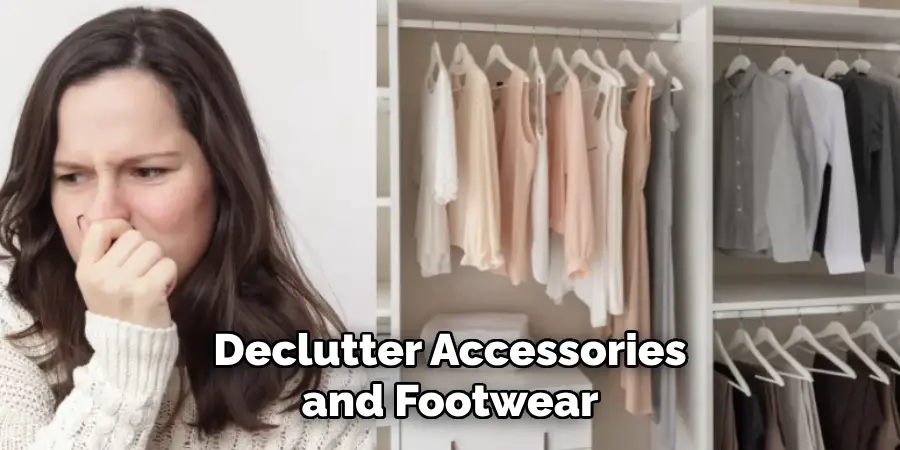
Step 8. Monitor and Maintain Your Wardrobe
After successfully downsizing your wardrobe and organizing it efficiently, it’s essential to develop habits to maintain its current state. Regularly review your clothing collection to ensure it continues to meet your needs and aligns with your lifestyle. Allocate time every season to assess what items are still relevant and evaluate for any changes in your style or circumstances that may affect your wardrobe requirements. Consider implementing a “one in, one out” policy, where you remove an existing item for every new piece you acquire. This can help prevent accumulating excess clothing and promote thoughtful purchasing decisions. Maintaining a clutter-free wardrobe preserves the simplicity and functionality you’ve worked hard to achieve, ensuring it remains versatile and enjoyable to use.
Step 9. Implement a Wardrobe Rotation System:
Consider implementing a wardrobe rotation system to optimize your newly downsized wardrobe further. This involves periodically rotating your clothing to ensure every piece gets its time in the spotlight and helps prevent certain items from wearing out prematurely due to overuse. Start by dividing your wardrobe into different sections or groups that you can cycle through over a specified period, such as weekly or monthly. This approach not only keeps your outfits fresh and varied but also maximizes the utility of each item, allowing you to continuously appreciate and evaluate your wardrobe’s versatility. A rotation system also highlights any pieces that are consistently overlooked, enabling you to make informed decisions about their suitability in your collection.
Step 10. Personalize Your Wardrobe with Signature Items:
To truly make your wardrobe an extension of your personality, incorporate signature items that reflect your unique style and character. These could be distinctive pieces like a statement necklace, a vibrant scarf, or an iconic pair of shoes that consistently make you feel confident and self-expressive. Signature items can act as focal points within your outfits, providing that personal touch that sets your wardrobe apart. As you consider potential signature pieces, think about items that resonate with your style and are versatile enough to complement a range of outfits. Integrating signature items thoughtfully ensures your wardrobe maintains its distinct identity while remaining cohesive and adaptable.
By following these steps, you can successfully downsize your wardrobe and create a functional, personalized collection of clothing that supports your lifestyle and personal style.
Conclusion
How to downsize wardrobe can be a liberating and rewarding experience, allowing you to streamline your clothing collection without sacrificing style or function.
You create a manageable and cohesive wardrobe by following a systematic approach that includes assessing your needs, organizing by season, prioritizing versatile pieces, and decluttering accessories and footwear. Implementing a maintenance strategy and considering a rotation system helps keep your collection fresh and relevant. Finally, incorporating signature items personalizes your wardrobe, ensuring it reflects your unique style while remaining practical.
By adopting these strategies, you cultivate a wardrobe that is functional, versatile, and deeply aligned with your lifestyle and personal taste.

